The ultimate guide to DropShipping

What is DropShipping?

Let’s start with the basics. If you’re new to retail or eCommerce and are wondering what DropShipping is, here’s a short definition:
DropShipping is a direct to consumer retail fulfilment method where a seller does not hold stock.
That means, in plain English, that a retailer or seller sells products, but doesn’t have a warehouse or have any stock. The seller just sells – they direct their orders to a supplier who send the order on their behalf.
To break it down step-by-step:
- The customer places an order, and makes payment – either on the seller’s eCommerce website, a marketplace or in-store.
- The seller immediately places an order for the item with a supplier, and makes payment.
- The seller pays the supplier for the item (including delivery costs).
- When payment has been received from the seller, the supplier processes the order and sends the item to the customer.
Customers shopping online may not know (and indeed in most cases, won’t care) that their order is being fulfilled this way.
DropShipping isn’t restricted to eCommerce sellers though. High street retailers are starting to expand their offering by engaging with DropShipping suppliers. When customers place orders in-store (with the benefit of being able to get advice and assistance from sales assistants) and payment has been taken, the supplier dispatches the order either directly to the customer’s home, or to the store for collection. The retailer makes additional sales, and the store (and the wider high street) benefits from additional footfall and impulse purchases, while the customer is more confident they have the right product.
Is DropShipping allowed?
We understand why some people think DropShipping sounds like it could be a scam. But legitimate DropShipping is absolutely allowed, and a real, viable option for sellers. There is, however, a procedure called retail arbitrage which is not allowed on many marketplaces. This is where a seller takes money for a product they don’t own, and don’t have access to sell it arranged with a supplier. Once they have the money with them, they find a listing for a lower price and pay them to send it to their customer. This is different from DropShipping because essentially, you’re ‘stealing’ a sale from someone else and making money on it. With DropShipping, the supplier doesn’t want to deal with the customer – they simply want to get paid and send the order! That’s the bit that you’re taking care of when you’re legitimately DropShipping.
If you search for retail arbitrage, there’s a lot of links telling you it’s possible and that you can still do it. However, we know of sellers who have had their seller accounts disabled on several marketplaces because they were practicing arbitrage. We don’t recommend using arbitrage as a strategy – fighting to get your account reinstated can be a huge challenge, and ultimately, you may be left without your account on that marketplace.
Key DropShipping terms
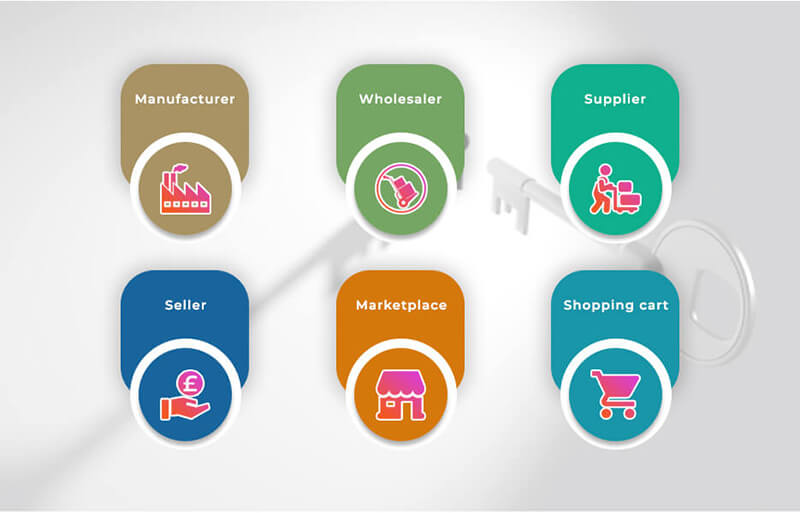
OK, so there’s lots of terms you’ll need to know when it comes to eCommerce and specifically DropShipping. Here are some of the main terms:
Manufacturer: The company that actually produces the product. A manufacturer may also act as a supplier.
Wholesaler: A company that buys from a manufacturer and stores it for sale to retailers.
Supplier: Similar to a wholesaler, a company that buys from manufacturers and ships products to customers for sellers.
Seller: A person or company that lists items for sale on different platforms.
Marketplace: A website that hosts sales for sellers. Examples include eBay, Amazon, Wish, Groupon and so on.
Shopping cart: A solution for eCommerce websites. Examples include WooCommerce, Magento and Shopify.
Pros and cons of DropShipping
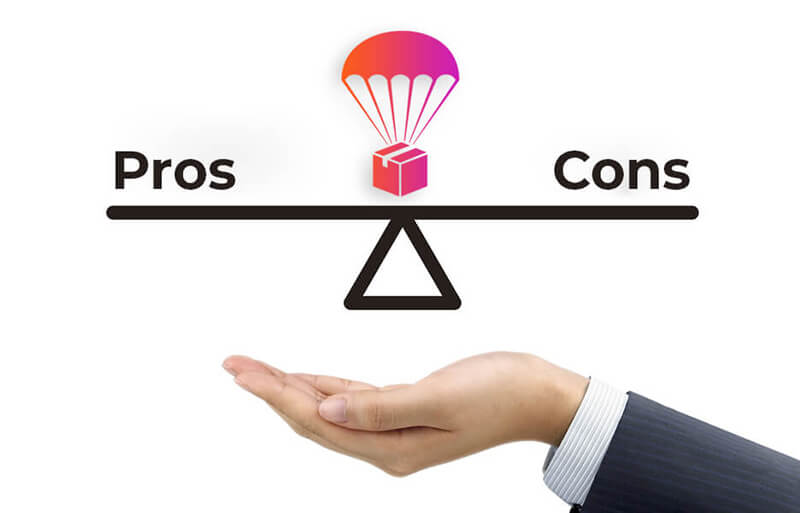
Although DropShipping is a brilliant option, it isn’t a one-size-fits-all solution for everyone – so it might not be for you. (If you decide it isn’t right for you – maybe right now, maybe ever – take a look at our low investment business ideas blog for more inspiration!) There are lots of reasons it might not suit you – whether you’re already in business or not. We’ll take a look at some of the advantages and disadvantages of DropShipping to help you decide next.
Advantages of DropShipping
There are loads of reasons DropShipping is a great method of making sales. Here are some of the main ones we hear people talk about the most.
Easy to start
If you’re able to find a great solution to help manage your DropShipping business, it can be incredibly easy to start. A well-designed platform will help you ease into selling, and means your business runs efficiently immediately. If you start out without a solution, trying to implement a solution down the line might end up being tricky.
For suppliers starting DropShipping orders, once their technology solution is in place, suppliers benefit from DropShipping sales with no extra effort. They don’t have to create and manage an eCommerce presence, deal with customer support or with marketplaces – they just pick, pack and dispatch the orders as they arrive in their system.
Low risk and low cost
Many people tell us they’re put off starting their own business because of the chance of failure, or because costs are too high. With DropShipping, there are relatively few costs – and usually these are limited to software or platform subscriptions. Risk is also significantly reduced, since there are no requirements for warehouse space or investment in stock. This means that DropShipping becomes a viable way to start a business where other options are unsuitable.
For many suppliers, setting up a direct to customer eCommerce presence would take up more resources than they are willing to invest. By fulfilling orders from sellers, they are able to increase their sales and profits more efficiently, without needing to invest in their own eCommerce presence. That’s because their sellers are taking care of the marketing and promotion of the product, so they don’t have to. Their sellers also take care of customer service, meaning that suppliers don’t need to invest in additional staff to take care of that either.
Flexibility
Many modern businesses start as an experiment to complement existing businesses, or as ‘side hustles’ aiming to supplement income. This means that flexibility is crucial to the success of the business. Luckily, a DropShipping business can be managed anywhere with a reliable internet connection. Since ‘trading hours’ are 24/7, 365 days a year, as long as customer service is handled promptly, there is no reason sales can’t be handled from anywhere in the world. With a good DropShipping system, sellers should be able to engage with unlimited numbers of suppliers. More suppliers means that the potential to scale up their business, with potentially infinite numbers of products, is limited only by the amount of time they are willing to invest.
Suppliers can benefit from the flexibility of DropShipping too. Since they control how many sellers they are going to work with, they can use DropShipping to scale up their business at the rate that suits them. They can choose what to offer through the DropShipping setup, from their entire inventory to just a few items. They can also take advantage of offering attractive mixed order options to help clear dead stock – which may be particularly lucrative for bricks-and-mortar retailers.
Easy to manage
Once an automated system is in place, DropShipping is very easy to manage for both sellers and suppliers. There should be little need for interaction between seller and supplier, and automation means that human error is almost eliminated. Generally, a good system will allow for sellers and suppliers to integrate with multiple marketplaces, and automate everything from the purchase through to shipping dispatch notifications.
Disadvantages of DropShipping
Although there are lots of advantages to DropShipping, there are some disadvantages that you might want to consider – especially if you’re looking to use it to diversify an existing business. Let’s take a quick look.
Low margins
We’ve put this first in the list of disadvantages because for most people, it’s the biggest hurdle to overcome. Since the margin on each product is smaller, sellers need to sell a lot of products. This can be mitigated in two ways:
- To make sales, sellers need to focus on creating great content for each listing and marketing themselves. In the beginning, much of their profit might be invested in paid adverts such as Google Shopping, or PPC (Pay-Per-Click) adverts. Once they begin to build their sales and get recognised as a good seller, it can get easier.
- Sellers can focus on higher value items, with a higher margin. It’s more difficult to find the right supplier, but the potential benefits mean that you can make a decent living from the margins while making a sale or two a day instead of trying to make 300 sales a day. Because of that, the customer service burden is much lower too.
Less competitive prices
When a traditional, bricks-and-mortar seller deals with a supplier, they are typically offered wholesale prices. That means the more they buy in one transaction, the lower the price per unit. With DropShipping, suppliers don’t typically give their sellers those preferential prices. That means sellers pay more per item – which contributes to those low margins we just talked about. Some suppliers will recognise volume of sales however, and give highly successful sellers a better rate once they have been working with them for a while.
Stock reliance
While DropShipping is incredibly flexible and allows sellers to react to trends in sales, it does mean that there is the potential for sudden stock shortages. Sellers are dependent on their suppliers having enough stock to fulfil their orders. If there is a sudden spike in demand for a certain product when their supplier is out of stock, sellers might end up being unable to take advantage of the trend. This risk can be mitigated by engaging with several suppliers, so that if one is out of stock, orders can be sent to another.
Huge competition
If you’ve searched DropShipping online (as you probably did to find this article) then you already know there are thousands of pages talking about it. If you search ‘how many dropshippers are there’ or similar online, you’ll find it hard to get anything like a straight answer –because the number constantly fluctuates. Small sellers start up and cease trading daily, and the number of DropShipping suppliers worldwide changes as regularly as businesses start offering it as an option or stop. But, suffice to say – there’s an enormous amount of competition. That doesn’t mean sellers should be deterred though! Rather, they should look to invest time and effort into their strategy, to ensure their listings, and their business stands out.
These might be the downsides to DropShipping, but the issues they present can be minimised, so don’t let them put you off. If you’re choosing from the right suppliers, you’re less likely to encounter these issues. Dealing directly with manufacturers, brand owners and wholesalers means you’re not dealing with unnecessary middle men. You can also eliminate the issues of dealing with suppliers from overseas that may have issues communicating clearly in good English, or who have different ideas about what ‘good’ customer service really is. We know some sellers who have tried to buy items from marketplaces such as Amazon and eBay, with a view to make money on those items. But since they were buying at retail price, those sales were scarce because customers would go directly to where the product is cheaper – on the same marketplace they bought from! Going directly to the source of those products is key to making sure your margins are the best they can be.
The key to successful DropShipping is reliable suppliers, situated geographically close to your customers. By using a platform like Avasam, you can connect directly with the right suppliers, and source the best products for you and your customers. Look for a platform that also automates all your DropShipping processes, and connects with marketplaces, shopping carts and shipping providers, without you needing to pay for additional functionality. The ideal platform does everything you need – from sourcing products to shipping to helping you grown, and frees your time so you can sell more.
Methods of DropShipping
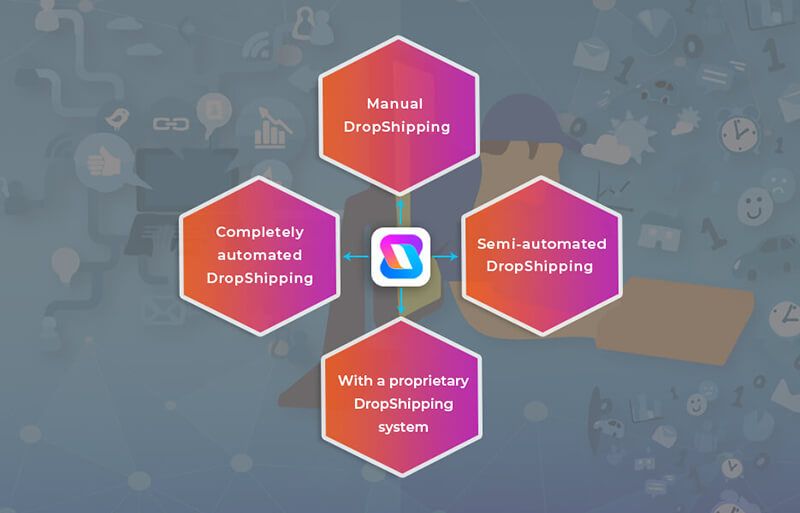
There are different ways to set up DropShipping arrangements, and each one may be appropriate depending on the type of business you have. We’ll look at the most labour-intensive methods first before getting to the most straightforward ways of DropShipping.
Manual DropShipping
This type of arrangement takes the most effort, but may suit bricks-and-mortar retailers who occasionally get requests for specialist items. It might suit car parts specialists, for example, who may not need to keep a part for a vintage vehicle in stock, but may need to help a customer find a particular part every now and again. When the retailer takes the order, they place the order with their supplier by phone, fax or email. When the supplier agrees, they take payment from the retailer, before sending the item to the retailer or the customer directly. Note how there’s no automation here – it’s all done manually, business to business. There’s a lot of scope for human error, and it will take quite a lot of time.
Semi-automated DropShipping
This is where a supplier might make their products available to sellers by providing their inventory as a file that can be downloaded from a shared location and imported to the seller’s system. The file needs to be updated on the seller’s system regularly. Orders may be made by file uploads, but there are still huge chances of mistakes being made – especially where sellers are less technically competent.
With a proprietary DropShipping system
Some suppliers have invested in their own DropShipping platforms, so sellers can connect to their inventory and place orders with them. It’s a lot more automated, but there are drawbacks. If you know you’re definitely only ever going to want to DropShip orders from one supplier, this might work for your business, but if you want to engage with several it might be trickier. You might find you need to engage with several suppliers, and adding multiple suppliers to your existing system might require the support of a developer.
Completely automated DropShipping
Completely automated DropShipping can be done using specially designed platforms. The best are designed to automate absolutely everything – from finding suppliers with the right products, to connecting with online marketplaces and sending shipping updates. By using these platforms, you’re not tied to a specific supplier – you can engage with as many as you like. There’s usually a cost associated with automated DropShipping platforms, but subscription costs are usually small in comparison with the sales they create for your business.
How much can you make DropShipping?
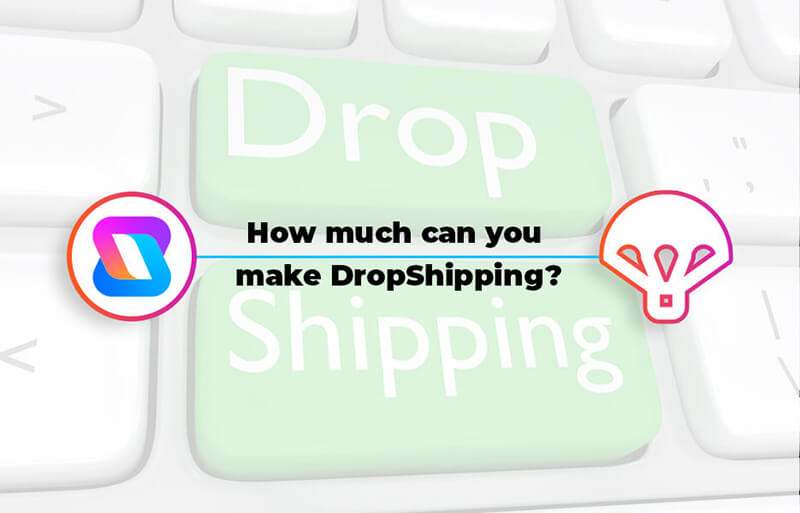
Again, it’s difficult to give a direct answer, because there are so many variables. It can depend on what your niche is, how many items you sell, and how much your margins are. If you are not currently employed, and you can put all your time and energy into planning and building your business, you can write your own paycheque!
Is DropShipping worth it?
This question is very subjective, and depends on you and what you’re hoping to achieve from it. If you’re aiming for a business that can make you some extra money as a side hustle – yes, absolutely it can be. It’s a flexible way to earn extra money in the gaps of time in your life – so if you’re saving for a house, extra travel and so on, it’s a good option.
If you’re looking to find a way out of your current 9-5 grind, DropShipping can help you get there too. Full disclosure though: it won’t be a quit immediately situation, or even inside a month. You’ll need to build your business gradually during evenings and weekends, and perhaps your lunch breaks too. The reward will be sweet though, once you have a solid business and you can finally submit that resignation letter!Imagine the feeling of knowing you won’t have to do that commute, or report to that manager again… If that doesn’t inspire you to get started, we don’t know what will!
If you’re looking for a ‘get rich quick’ plan then DropShipping might not be worth it for you. DropShipping can be easy, once you’ve got your system or platform in place and you have your processes perfected. But to get to that place, and to be making sales consistently, you’ll have to invest a lot of time and effort. Depending on your niche and what you’re actually selling, it might be years before you’ve perfected your business strategy and are exceeding your targets.
Starting a DropShipping business
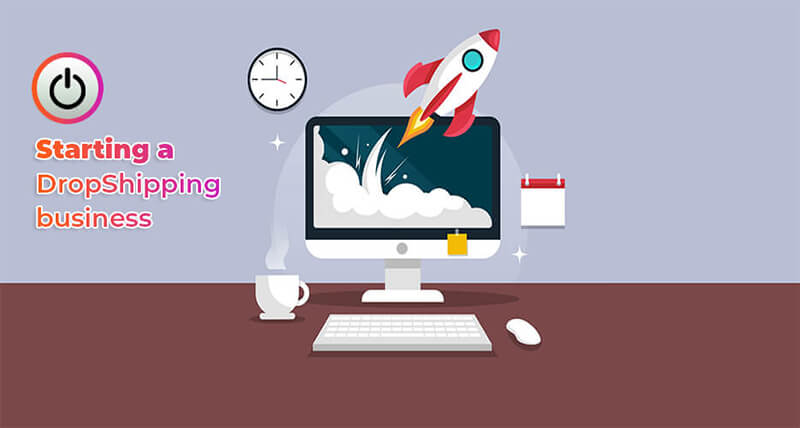
Starting a DropShipping business might seemdaunting, especially if you’ve not had experience selling or you’re not confident with technology. That doesn’t mean you should be put off completely though! You just need to make sure you get the right tools, and do enough research so you can learn as you go.
Especially if you’re brand new to selling, we recommend using a platform like Avasam for the most streamlined experience. You can go ahead and create your own setup, but without developer skills and knowledge of API connections, you might find it tricky, or time-consuming.
Who can start DropShipping?
Literally anyone can start a business DropShipping! There’s no restrictions – although under 18s in the UK can’t have a business bank account or get credit. That means teenagers will need the support and guidance of their parents or guardians to develop their business. If you’re reading this and are under 18 and thinking about starting to sell, great – we applaud your tenacity. We don’t recommend abandoning your education, (in fact, quite the opposite – we advise you to learn as much as you can!) but if you’re looking for work experience, to start a business so you’re ahead when you leave school or you just want to earn some money, DropShipping can be a good place to start.
Outside of UK teenagers, it doesn’t matter who, or where you are – as long as you have an internet connection and a PC or mobile to work on, you can start DropShipping! The main thing is that you can use a PC or mobile device well enough and can put enough time in to build your business. You don’t need to be in the same country that you’re DropShipping to either – you could be selling in the UK but living in Australia, or selling in South America but living in Japan… The flexibility of DropShipping is one of the major advantages of the business model, as we’ll discuss later!
Who is DropShipping not suitable for?

DropShipping is a great option for setting up your own online business, but it isn’t right for everyone. Here are a few cases where DropShipping might not suit the individual:
Brand focused entrepreneurs. Creating a brand that customers become loyal to can be tricky. Building a brand that using DropShipping can be even harder! There are so many parts of the customer experience out of your control. If your supplier goes out of stock suddenly, you may need to cancel customer orders. You don’t have control over the customer experience – you don’t get to influence packing or shipping options. If you’re promoting a luxurious image, but orders turn up in a brown cardboard box, customers may opt for a cheaper competitor in future. With Avasam, you have greater control over out of stock levels and working with reliable suppliers – but even with Avasam, selling online isn’t for everyone.
Entrepreneurs aiming for high margins. DropShipping can disillusion entrepreneurs because the margins on each product can be so low. With traditional DropShipping items and suppliers, gross margins can be up to 20%. After paying transaction fees, marketplace and shipping fees and so on, profits on each item can end up being tiny – especially on lower cost, trending items. There are some online sellers who are making over £1 million, but their businesses are only making £40-£50,000 in profit. That’s why it’s so important to find your niche, and ensure it’s profitable before starting.
Non-creative marketers. When selling online, you start out as a small fish in a very, very big ocean. You could undercut and reduce your margins to fractions of pennies, but even then, you’re up against it. Other businesses might outperform you simply because they are the supplier themselves, and have years of great reviews. That means you have to be incredibly creative in your marketing. If you’re hoping to rely on Google Ads or Facebook Ads, you’re not going to succeed. You’ll need to find out where online your target customers are, and how you can appeal to them. That involves significantly more work – potentially creating your own images, videos and so on. If that doesn’t sound like you, there are ways round it – you might work with freelancers to create video, for example. But that cuts into your margins, so it might not end up being viable long-term. We’re not saying if you can’t do those things that you shouldn’t try – absolutely not! But just be aware that you might need to invest more time and energy into your sales campaigns.
We say it a lot, but for good reason: do your research. Figure out what you want to achieve by creating your business. Once you’ve done that, you can decide for yourself whether DropShipping is worth it for you or not. If it isn’t, you can find other business inspiration here – and we wish you the best of luck with your endeavours!
How to find DropShipping suppliers
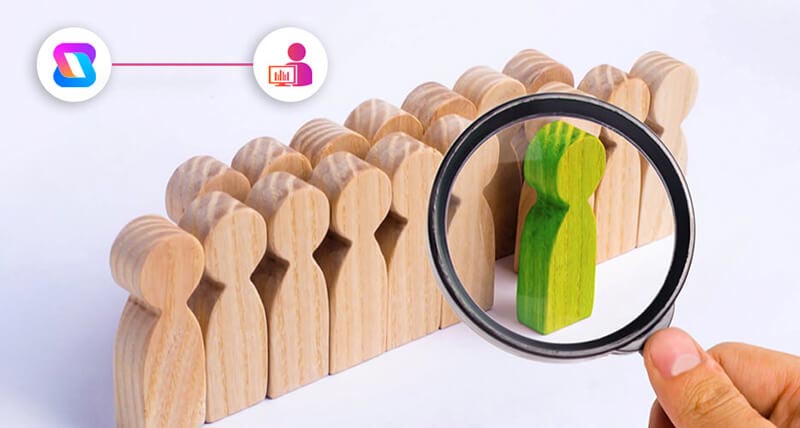
When you search online for ‘DropShipping suppliers’, you’ll find lots of links to overseas suppliers. While DropShipping from China (and elsewhere) can be a solution, we hear lots of reports of difficulties. Issues include misunderstandings due to language barriers, time zones causing delays in communication and long delivery times, and just a lack of accountability in general. We’re not saying that DropShipping from China isn’t a good idea – we know some sellers make great profits from it. We’re simply providing you with information we hear about, so you’re fully informed.
These issues aren’t the only complaints we hear, but they’re some of the biggest concerns that deter sellers. Not only that, there’s thousands of middlemen and scams around DropShipping. The importance of the supplier means many potential sellers, after doing research, decide not to pursue creating a DropShipping business. There’s just too many variables that mean they could end up out of pocket.
The good news is that doesn’t have to be that way. Many suppliers can be found in person at trade events. If you can’t make one of those, here’s a few ways you can avoid the scam artists when doing your research:
Real suppliers won’t charge fees that don’t directly relate to the service.
There’s a few reasons a supplier might charge you, but they won’t charge you fees simply for doing business. There’s a couple of reasons you might expect to be charged though:
- Supplier directories may charge a fee to access their information and feeds. It is possible to create a business without using supplier directories – you just might need to do more research.
- Some suppliers have minimum order sizes. That means you may need to make some up-front payments, so you have some credit for your orders. As your business builds and you show your supplier that you’re reliable, they may provide a credit account for you. This is at their discretion though, and you should not assume that it is always possible.
- Per-order fees are standard and expected by many suppliers.
Suppliers don’t usually deal with the public.
As a seller, you’re going to need wholesale prices in order to make a profit on what you’re selling. Otherwise customers will simply go straight to the supplier and get the better price – you would, wouldn’t you? A reliable supplier might have their own eCommerce presence, but they will have wholesale prices available to sellers. If a potential supplier is offering wholesale prices to the public, they’re simply a seller. That’s fine, but working with them won’t be worth it for you.
There are exceptions to this rule, but they’re rare, and usually relate to a supplier that has grown from a seller, and retains a small presence in a particular niche.
Reliable suppliers are contactable.
If you find a website for a supplier where there are no phone numbers, use caution. Most reliable suppliers will have a phone number that is manned during office hours as a minimum. They want your business – otherwise they don’t make money.
When looking at their website or email communications, check their work. The odd typo is inevitable in a busy business – but if their email and website is full of mistakes, again, be careful. Similarly, if they take days to get back to your email and have vague excuses for why, alarm bells should sound. Also, be concerned if they won’t give you a firm agreement on the cost. Whether a single cost, or a banded structure based on how many you sell, if they won’t commit, why should you? It’s not unusual to renegotiate periodically, but how can you plan your prices without knowing your business costs, and make a profit?
Great suppliers are very happy to prove they’re great at what they do. When speaking with a potential supplier, ask them for a reference. If they can’t give you names of businesses that they have worked with, there’s likely to be a reason for that.
At this point, you might be wondering… Is there an easy way to find a DropShipping supplier? The good news is, yes!
The easy way to find DropShipping suppliers
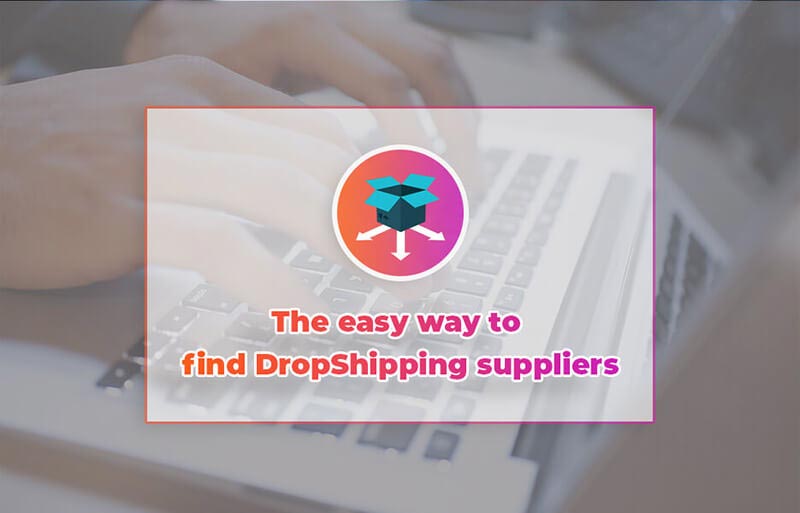
Your business selling is dependent on your suppliers. That means it’s critical that you find good ones! However, it’s traditionally been difficult to find reliable suppliers – particularly if they’re overseas. If you search online for ‘DropShipping supplier’ you’ll find thousands of pages promising great service, prices and so on. But there are also scam pages out there – we reckon there’s more scam pages than reliable suppliers!
If you’re looking for reliable (often, but not exclusively UK-based) suppliers, you can find them at trade events. We have often been in attendance at Spring Fair and Autumn Fair,where we meet great suppliers, but there are plenty of other events too.
If you’re searching online, it’s definitely worth checking UK suppliers on websites like Trustpilot. Although you might encounter complaints on these pages,consider what the complaint actually is. It might be something that is unlikely to bother your business.
The key to finding reliable sellers (that you don’t have to wonder about!) is knowing where to look. Not only that, if you have the right system, you can use more than one supplier with no problems.
You might think we’re selling ourselves a bit here (we are!) but with Avasam suppliers, questions about reliability are reduced. We’re not promising that our suppliers are all 100% perfect, 100% of the time – humans are involved, after all! But our Avasam Verified Supplier Programme, makes it easier for sellers to find the products they are looking for, with assurances about the service on offer. We have strict criteria for suppliers to be awarded Avasam Verified Supplier, and even stricter for Avasam Verified Platinum Supplier status. Considerations include order delivery time, English-speaking support staff, low dispute rates and so on. Because our suppliers are all UK-based or close by in Europe, there are less chances of problems with communication, service levels and so on that get reported with ‘from China’ DropShipping setups.
Which marketplaces are best for DropShipping?
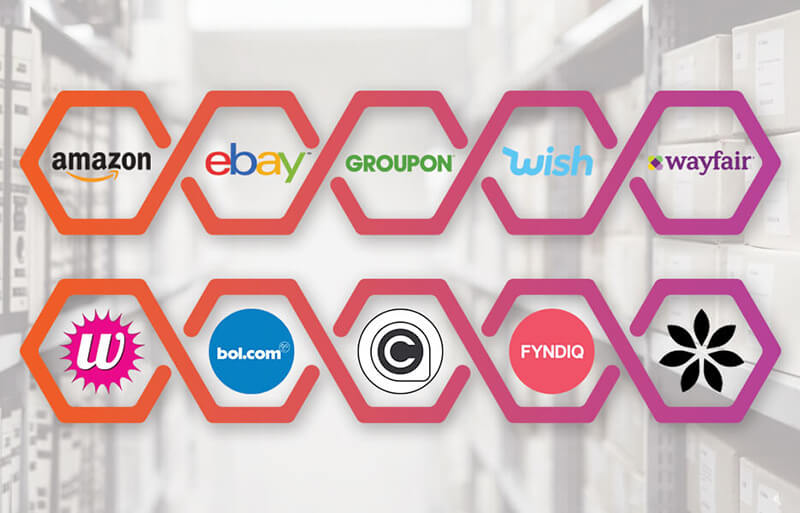
Again, there’s no right or wrong answer here, because it really does depend on your niche and where your target customers are. But here are the 10 most popular marketplaces with Avasam users:
- Amazon
- eBay
- Groupon
- Wish
- Wayfair
- Wowcher
- Bol.com
- Coolshop
- Fyndiq
- Privalia
If you’ve not heard of at least the top half of the list and you’re considering getting into DropShipping, you’ve got a lot of research ahead! Bol.com, Coolshop, Fyndiq and Privalia all have their customer base outside the UK, so you might not have heard of them. You can consider these marketplaces (and others) to scale up your business and start expanding your business worldwide.
How to DropShip on Amazon
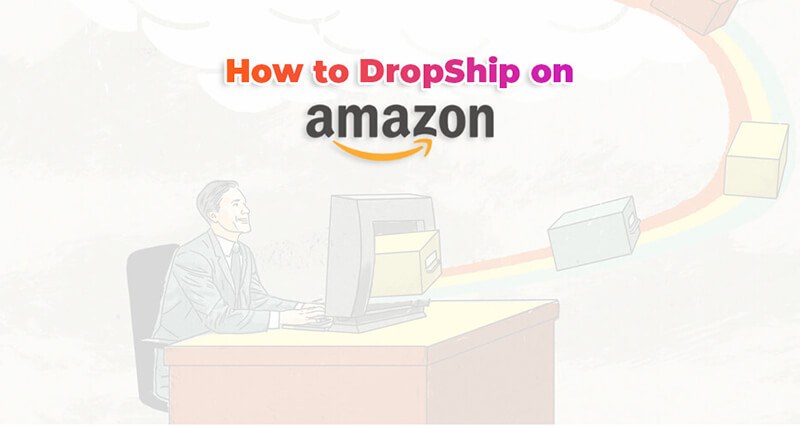
DropShipping on Amazon can be amazing. It’s an extremely busy marketplace, but with over 197 million people worldwide heading to Amazon.com alone (Amazon has different websites for different locations) Amazon is a marketplace not to be missed.
There are many things you will want to know about DropShipping on Amazon, but here are just a few points we think you need to know before you get started:
- Sellers cannot purchase products from another online retailer and have them ship directly to a customer (retail arbitrage).
- Sellers must ensure their business information is on all packaging sent to customers.
- Order packaging must show the seller’s business, not a third party. (the supplier’s details should not be shown)
- Sellers must deal with returns and complaints – not the supplier.
- Amazon seller agreements and policies must be complied with.
Follow these steps to get started on Amazon:
1. Find a great supplier, or a DropShipping platform that connects with Amazon.
Whether you select a platform or to work with a supplier directly, ensure they are reliable and have the right integrations for your business and that they’re able to scale up as your business does. We recommend Avasam for the most flexible and scalable DropShipping business.
2. Ensure you have the right products.
Although it seems like you can buy almost anything on Amazon, there are in fact tight restrictions. As you might expect, anything illegal in the country is off-limits. There are also restrictions when it comes to your content – so it’s important to check the list before proceeding. Getting your Amazon Seller account unlocked can be a lengthy and difficult process, so do your homework and make sure you can avoid running into trouble!
3. Set up your Amazon seller account.
You’ll need to work out the best plan for your business – if you’re planning to sell lots, get a professional seller account and pay the subscription, so your fees are lower. Once you have your Amazon seller account, you can start listing those products and making your sales!
Other tactics for success on Amazon:
- Win the Buy Box
- Use other platforms to help your business grow
- Aim for 95% (or higher!) seller rating
- Always do keyword research
- Price products realistically
- Offer a good discount code
There are thousands of pages of advice about selling on Amazon available online – so we won’t try and replicate that here. These are the main pointers that we recommend starting with, before moving on to more advanced tactics and refining your approach to DropShipping on Amazon.
How to DropShip on eBay
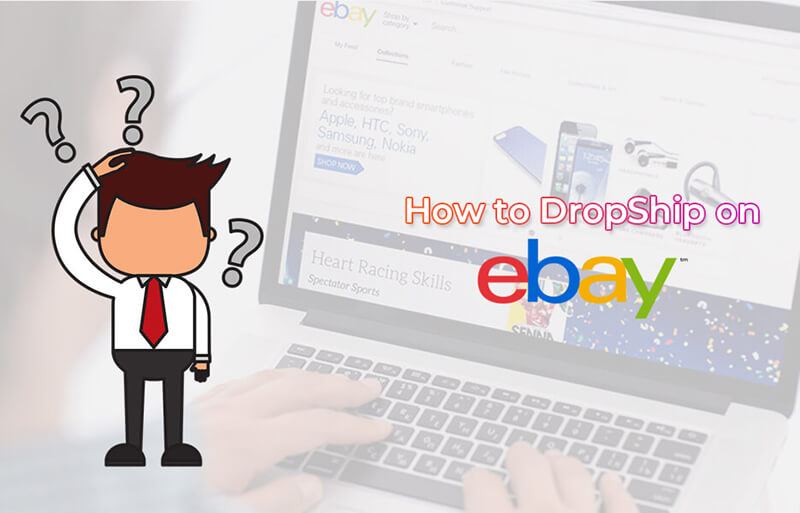
eBay is easily one of the UK’s favourite marketplaces, and has over 182 million active buyers worldwide. That means if you’re starting to sell online, it makes sense to add eBay to your setup. Here’s a few steps to getting started selling on eBay:
1. Find your supplier or DropShipping platform.
If you’ve carried on reading from Amazon, this is going to sound familiar! Getting your supplier and/or platform right will be key to your success on eBay. They need to be reliable, and have the functionality you and your business need, so do your homework. Using Avasam is a good place to start – but you know your business, so make sure it’s the right move.
2. Get the right products.
You will have done your research, and have a defined target customer, so you’ll know what they’re looking for. Like with Amazon, there are lots of regulations you must abide by when selling on eBay. There’s a prohibited and restricted items list, so make sure you’ve checked these before you get started.
3. Set up your eBay seller account
Once you’ve set up your account, you’ll need to sign up for your subscription so you can set up your eBay shop. Make sure you’ve got the right eBay seller package for the amount of sales you’re expecting to make. Once you’ve got your account, you can begin the listing process. Bear in mind though, as a brand new seller, you might find eBay limits the number of items you can sell each month, and you won’t be able to use bulk listing or editing tools until you’ve been selling for more than 90 days, and when you’ve had more than ten positive ratings.
Again, there is so much great advice out there about selling on eBay that we couldn’t hope to replicate it all here. We recommend starting with the expert advice that Team eBay provides.
How to DropShip on Shopify
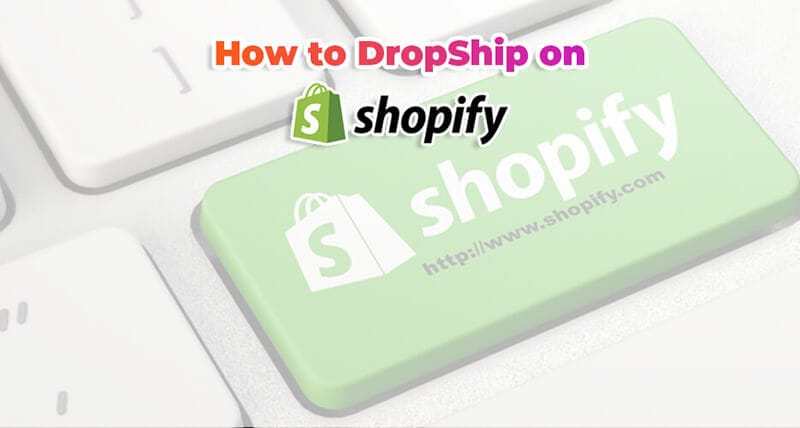
DropShipping on Shopify is a bit different to selling on Amazon or eBay. That’s because Shopify isn’t a marketplace – it’s an eCommerce platform for retailers to create their own online stores.
Ultimately, the first two steps to successful DropShipping on Shopify are going to be the same as Amazon and eBay – making sure you have a great supplier and getting the right products for your business and your customers. When you’ve got your Shopify store set up, you’ll want to add products from your suppliers. If you’re using a DropShipping platform like Avasam, you’ll find a Shopify integration available that means you can list your chosen supplier’s products on your Shopify store.
Which shopping carts are best for DropShipping?
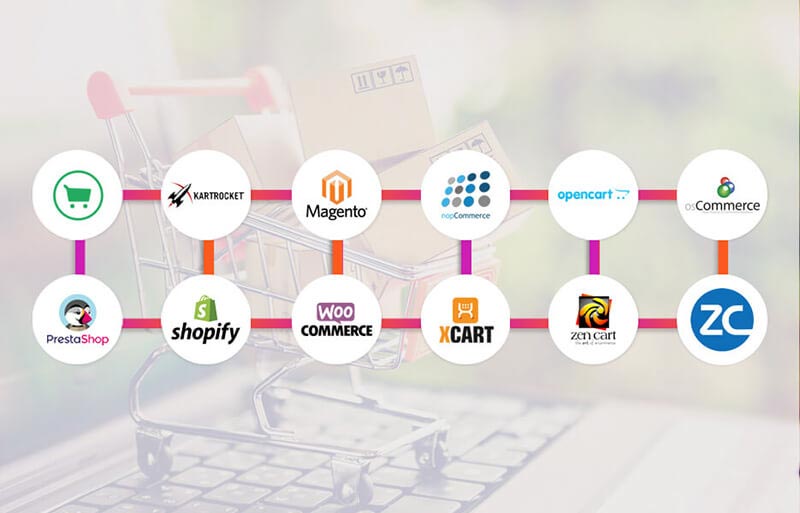
When you’re setting up your own website to sell on, you want to know which one is going to work best for you. You’re going to need a robust, reliable setup that has everything you need for a secure website that inspires confidence in your customers.
Many Avasam sellers rely on Magento, WooCommerce for their eCommerce website. That’s because with Magento and WooCommerce there are thousands of customisation options that mean your website can be exactly what you need it to be. Those extensions, plugins and addons can be the key to your success – but if you don’t have any developer skills, you might want a hand configuring them.
- 3dcart
- Kartrocket
- Magento
- Magento 2
- nopCommerce
- NSCommerce
- OpenCart
- OSCommerce
- PrestaShop
- Shopify
- WooCommerce
- X-Cart
- Zencart
- Zencommerce
For sellers who don’t want the hassle of configuring their website, Shopify is often chosen to create an eCommerce website. It was designed specifically for sellers who don’t have, or want to learn developer skills. There are hundreds of customisation options that require minimal input to configure.
Although Magento, WooCommerce and Shopify are the most popular, they’re not right for every single business. The main thing we recommend new sellers check is that whichever shopping cart they choose, they ensure it can seamlessly integrate with your DropShipping setup. Avasam has a growing number of integrations for shopping carts. They’re all great options – and whichever one you decide on, you know your website orders will be processed effortlessly.
Which countries can I DropShip to?
In theory, you can sell DropShipped items anywhere in the world that has a reliable postal service. However, there are some countries that will perform better for sellers. You’ll need to consider the size of the population, delivery costs and demand, competition and pricing, and the lifestyles of the population. At best, adult items and skimpy lingerie may not sell well in conservative or devoutly religious countries – at worst, you may encounter legal issues that ultimately put you out of business! That’s why we recommend always doing your research before starting.
Best countries to DropShip to
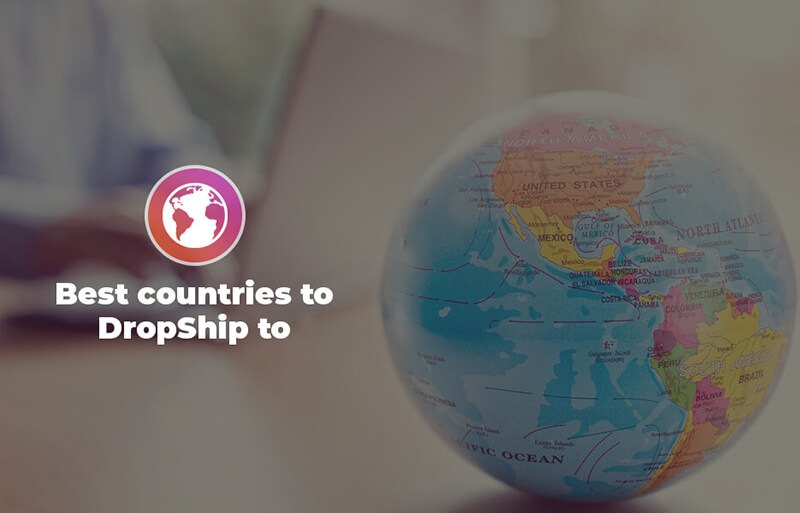
Again, it’s one of those things that depends on plenty of variables! Your niche, what you’re selling and the cost of shipping will influence whether it is worth selling to the country. Generally, most Avasam sellers will start by selling in the UK, and then move to selling in Europe. There is huge potential for sales in Scandinavia and even New Zealand, if you’re using the right suppliers and they’re using the right shipping companies, or if they are, or can use fulfilment centres local to that country.
Here’s our seven best-performing countries for DropShipping:
Australia – Amazon’s local site in Australia only launched in 2018, yet their eCommerce industry took over £16.5 billion in 2018. That means there’s a huge amount of potential for selling in Australia.
Brazil – With a massive population of over £209 million, by 2022 their eCommerce market is expected to exceed £31.6 billion. Why not be a part of it?
Germany – German sales online are expected to exceed £51.5 billion in 2019 and at least 85% of the 81.1 million population are internet users. There’s significant room for eCommerce growth in Germany, and being geographically relatively close, shipping costs aren’t prohibitive.
Italy – Italy has the largest market for luxury products in Europe. With high fashion labels including Armani, Versace, Prada and Gucci growing out of Italy, there’s no surprise there are 16.9 million online shoppers there.
New Zealand – New Zealanders spent over £2.15 billion online in 2018. Over a third of the population shop online regularly, and since there are no language barriers to overcome, New Zealand makes a great target for sellers.
Spain – With a population of 46.72 million and high levels of brand awareness, the Spanish people spent over £24 billion in 2018.
Sweden – The whole of Scandinavia is a good place to grow your business actually, but Swedes are expected to spend over £15.5 billion online in 2019!
The UK – With the UK eCommerce market expected to reach £106.46 billion this year and a population of over 66 million, there’s a huge potential for selling just within the UK.
Countries to avoid
As we already said, there are no countries that are absolutely off-limits for DropShipping in theory. In practice, however there are countries that you might want to avoid DropShipping to. China and India, for example, are difficult countries to DropShip to because there is so much competition there already. Not only are their marketplaces flooded with sellers, they’re full of products made in-country, so you’re unlikely to make good money selling there.
As far as other countries are concerned, it might go without saying, but it’s advisable to try and avoid countries where there is conflict.Damaged infrastructure, general lawlessness and other issues in war zones means you are likely to encounter problems with items being undeliverable, being stolen and so on.
Although there is risk of fraud worldwide, it’s worth knowing where there are high amounts of fraudulent transactions. We’ve heard of high numbers of fraudulent transactions taking placerecently in Indonesia, Afghanistan, Pakistan and Malaysia. If you decide to sell in these countries, make sure you do very careful research, and consider using marketplaces such as Lazada, so you have some seller support.
Best items to DropShip
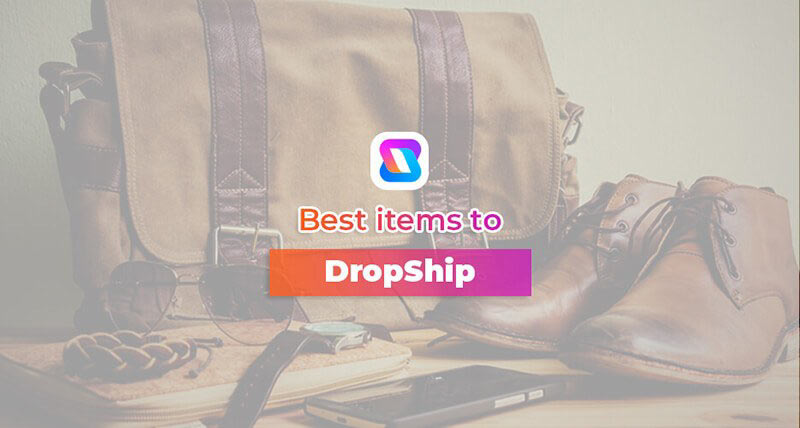
We examined some of the best items to DropShip in our blog post Small business ideas that’ll make you money. In that post, we made recommendations for targetcustomers, how to promote the items, how to cross-promote and so on. Take a look at that post as part of your research, but here’s a few items that sell well:
- Inflatable sofa beds
- Garden hoses
- Travel bags
- Laser hair removal devices
- Beard oil
- Strapless bras
- Sunglasses
- Athleisure
- Power banks
- Wireless earphones
An important point to note is that the bestselling items change constantly. By the time you read this post, other items might be selling well and trending online. These items have been selling well consistently for a while, but it’s definitely worth doing your research before jumping in. Some trending items are seasonal (Christmas jumper anyone?) but the beauty of DropShipping (particularly with Avasam) is that you can add and remove items from different suppliers effortlessly.
Best niches for DropShipping
You’ll hear this question a lot in retail and in eCommerce: “what’s your niche?”
What you’re being asked is – who are you targeting, and what’s your USP – your Unique Selling Point. Niche products are items that are popular with a particular section of the population.
If you’re looking to create a business that encourages repeat custom, finding a niche will be key to your success. You might sell products from one category, a single colour, or to target a particular type of customer.
However, it’s not as simple as deciding ‘I’m going to sell red hats that fit dachshunds that enjoy eating cheese’. (yes, that’s a random example, we know – it was supposed to be!) You must do your research carefully, because your potential customer base is so much smaller than if you’re selling trending items.
Three steps to identify profitable niches:
1. Look at your hobbies or interests. If you have a specific interest – sport, craft, etc – you might have already identified a gap in the market. Maybe you’ve found it hard to get exactly what you want, or maybe what you’re looking for simply isn’t there.
2. When you’ve identified your gap in the market, you’re going to need to do lots of research! What items are missing from the market, who are your target customers, where can you market to them etc.
3. Find data. This is your evidence that your items will sell. If you can clearly show that there is a gap for your items, you’re onto a winner.
You might not find the exact data you’re hoping to. If you don’t find that data, there’s a few things you can do:
- You can back off from the idea completely and look for something else to sell.
- You can reassess – did your research add up properly? It might still be a great idea, you just missed something.
- You can take a chance and run with it anyway. Your gut instinct, combined with some great marketing might mean that your idea ends up being a winner.
We don’t particularly recommend one way or another for finding your niche – do what is right for you and your business. The beauty of DropShipping is that because it’s low cost to start, your risk is low too. So if your gut instinct is telling you to go for it, give it a try! With Avasam, there is no cost until you’ve had more than 10 orders – so there really isn’t any reason to not try your ideas out. Sign up to get started – the only thing you need is your email address.
Best categories for DropShipping
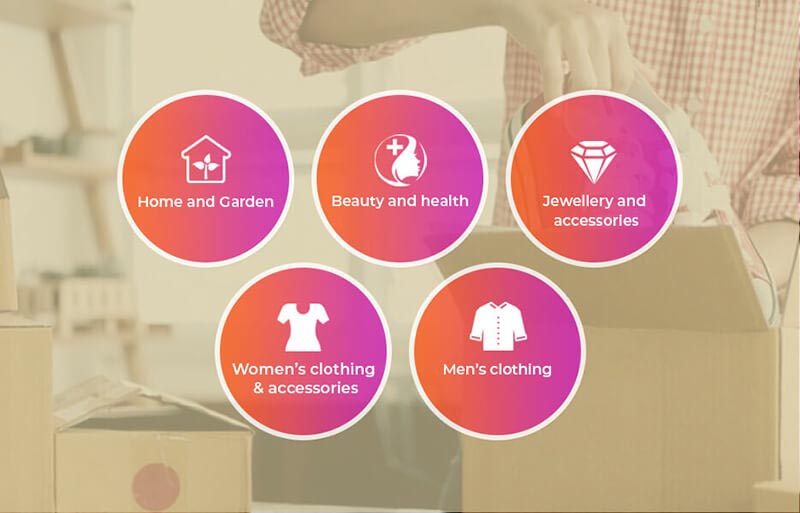
You could take the route of selling what is popular – but the market is saturated with sellers doing exactly that. Many sellers start with one category though, and expand their business as they become more experienced. Here’s the top five categories for DropShipping in the UK:
- Home and Garden
- Beauty and health
- Jewellery and accessories
- Women’s clothing & accessories
- Men’s clothing
Globally, the popularity of categories are roughly the same, but may differ from country to country. Think logically – customers in Scandinavia want different items to customers in Australia and Brazil just by virtue of the weather! You might still make sales, but changing the focus of your marketing in different countries might be the key to your success there.
DropShipping trends for 2019 and beyond

If you’re starting a DropShipping business this year, or next, then you’ll want to know the latest developments so you’re not behind before you even get started. Here are the biggest trends in DropShipping businesses right now.
Automation
More and more, businesses are looking to automate their DropShipping processes. That’s because not only are they able to sell more, they’re able to do so more cost-effectively, and because automation dramatically lowers the chances of human error. Less mistakes means happier customers, which makes for better company reviews, increased trust and more chance of customer loyalty.
Multi-channel DropShipping
Customers don’t stick to just one marketplace when they’re looking to make a purchase. Sure, many people will head to Amazon or eBay first by default, but they will typically look around to check they’re getting the best deal. That means that sellers who are listing their products on different marketplaces have more chance of making sales if their products are on multiple platforms. Not only that, sellers can make sales internationally if they are listing on marketplaces that are popular in different countries. In order to manage sales on multiple channels, sellers are using automated platforms like Avasam. This means sellers can make more sales, on more marketplaces and shopping carts, without additional work being required.
Retailers who have bricks and mortar store locations can also make additional sales with DropShipping using this method, selling on eBay, Amazon, Groupon and so on, as well as selling on their website and in-store. This omnichannel approach – where customers receive the same great customer experience, wherever and however they encounter the brand – is being applied by more businesses as they grow further.
Better payments
All customers are looking for secure payment methods, which is another reason customers head for marketplaces. They know and trust that their payments are protected, and they have recourse if something goes wrong. When it comes to shopping on a brand’s website, the issue of abandoned carts is the biggest problem. Even when customers spend time on a website and add products to their cart, around 70% of carts end up abandoned. It’s estimated that around 28% of cart abandonment happens because of long, or complicated checkout processes.
These issues mean that sellers are taking steps to make their checkout processes, and their payment options as secure as possible, but with the most amount of flexibility too. With many options available to sellers, including website integrations such as PayPal, Payoneer and Klarna offering solutions, there’s no reason to miss out on sales because of a lack of options for customers.
Sustainable packaging
With sustainability hitting the headlines and many consumers actively refusing plastic, sellers are encouraging their suppliers to use recycled packaging, and ensure it is also recyclable. Since customers can choose where to shop, many also choose to avoid companies where excessive use of packaging happens. Some customers may even go so far as to leave damaging reviews about the amount, or type of packaging they receive. That means although sellers using DropShipping suppliers to fulfil their orders don’t send the orders themselves, packaging should still be a concern, and talking to suppliers about using better options. With more sustainable options today than there ever has been, at realistic prices, there really is no excuse to not do the right thing for the environment.
We know this has been a huge read – if you’ve made it this far, thanks for sticking with it! If you did make it this far, you’re almost certainly on the verge of starting your DropShipping business, or you’re looking for ways to diversify your business. If you’ve got further questions, please get in touch – our team are happy to talk to you further about how DropShipping can work for you, and whether Avasam is the right fit for your business.

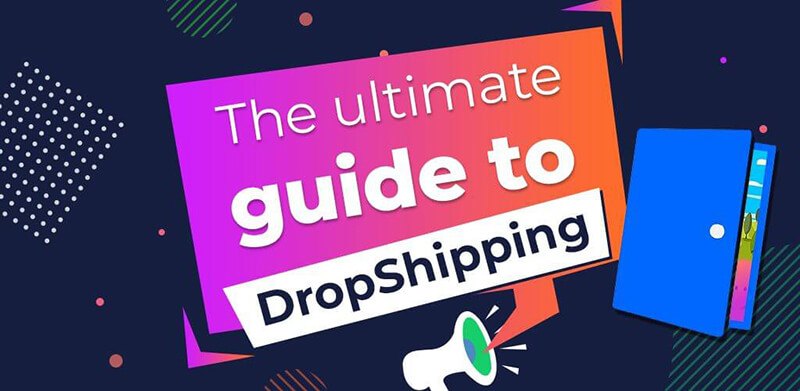


DropShip products from verified suppliers to diversify your inventory and scale your eCommerce business
Thanks, Dawn
In general, dropshipping adds one more chain between the “real” seller and the customer: the dropshipper. So, in general it will take one more step to accomplish anything. For example, if a customer wants to cancel an order, he/she will notify the dropshipper, and then the dropshipper will must notify the seller. This can complicate the process for both the dropshipper and the customer, for example if the seller has sent the package.
So, in most cases, it will mean a slower time which often lead to a worse customer experience.
If the dropshipper understood the product well (and the overall processes), this can help the overall customer experience, because the dropshipper can answer questions directly including providing basic customer service.
Many things can be done to improve this, but as mentioned, overall dropshipping will translate to a slower overall time.
Helo
I have already started dropshipping but it’s taking a while to build up some steam. Iam interested in avasam but I would like to speak to someone on the phone. Could this be possible?
Regards
Stephen Downey